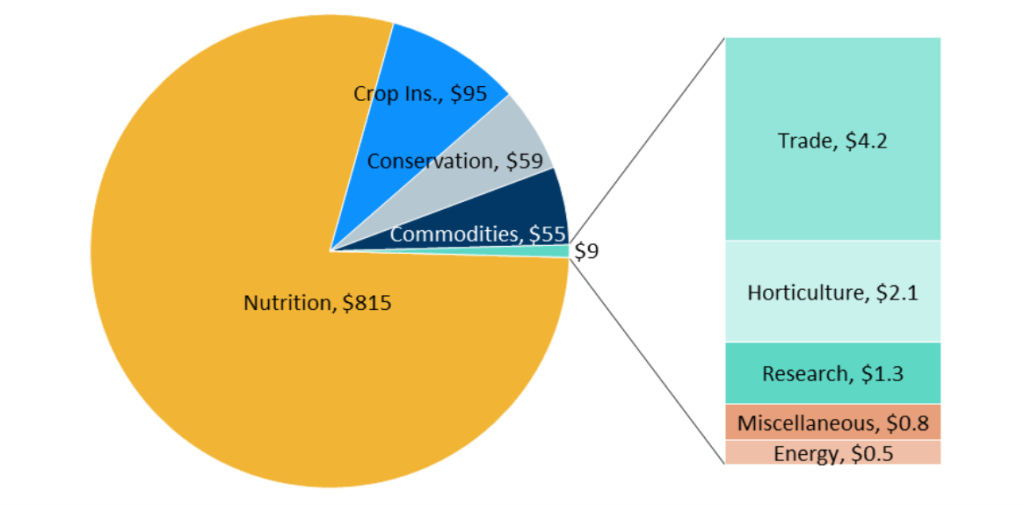The Farm Bill is the most significant environmental law Congress will address this year. This third of four blogs explains how it can help American agriculture be more resilient and climate-friendly.
Most Federal Farm Bill programs require Congressional reauthorization every five years. Congress passed the last Farm Bill in 2018 and Congressional leaders aim for a new Farm Bill by mid-2024.
While much of the public debate addresses the Farm Bill’s nutrition programs, the programs with the largest environmental impacts are conservation subsidies, research, and commodity production subsidies and insurance.
 Baseline Funding for Farm Bill Programs ($ billions; FY 2022-2031). Source: Congressional Research Service, Preparing for the Next Farm Bill (2022).
Baseline Funding for Farm Bill Programs ($ billions; FY 2022-2031). Source: Congressional Research Service, Preparing for the Next Farm Bill (2022).
1 – Realign Conservation Programs for Maximum Effectiveness
Farm Bill conservation programs provide over $6 billion annually to help mitigate agriculture’s ecological impacts. The Environmental Quality Incentives Program and Conservation Stewardship Program together grant about $3 billion annually to support environmentally friendly agriculture projects and practices such as cover cropping, diverse crop rotations, or vegetative stream buffers. But much of the programs’ money funds manure lagoons for giant livestock facilities and irrigation in arid lands, which can increase emissions over the long-term. Congress could better target these programs to address climate change.
The Conservation Reserve Program (CRP) pays farmers about $2 billion per year to return cropland to a fallow state that can better sequester carbon. But CRP contracts are not always focused on the most ecologically important lands. Moreover, CRP contracts are generally for only ten years (although a 2018 program allowed some 30-year contracts). When contracts expire, the land is often re-cultivated, undermining the environmental benefits. It would be better to focus the CRP on ecologically sensitive land (such as stream buffers) and extend the terms of CRP contracts to 30 years. Even better, expand the Agricultural Conservation Easement Program, which now receives only about $400 million annual funding. (To be most effective, easements should also be tied to using climate-friendly practices.)
2 – Knowledge Underlies Agriculture’s Climate Success
Public agricultural research focuses on critical, widely-shared knowledge, yet public funding for agricultural research was cut by a third from 2002 to 2019. Among other things, Congress could increase funding for the ten regional climate hubs that link U.S. Department of Agriculture research and scientific experts with farmers. Similarly, additional support for the national and regional agroforestry centers and perennial crops would pay off quickly.
Sharing knowledge is also critical. The Farm Bill can expand farmer-to-farmer training and experience sharing, providing big impact at little cost. And, to partly address the long history of discriminatory treatment of non-white farmers, Congress should set aside 30% of all climate-specific research, education, and outreach funding for institutions serving Indigenous, Black, Hispanic, and other communities of color.
3 – Shift the Safety Net for Climate
The Farm Bill’s production incentives pay farmers based on past production. This encourages chemical- and energy-intensive cultivation of commodity crops and impedes crop rotations. Revising payment metrics can shift impediments to climate action into incentives.
The predominant modern government support is the federal crop insurance program. Taxpayers fund over 60% of the premiums. However, today’s crop insurance system often codifies unsustainable farming practices and rewards producers for farming in environmentally sensitive areas, thus increasing climate risk. (It’s also wasteful – a third of all crop insurance subsidies flow to insurance companies and agents, not farmers.) Congress could realign crop insurance with climate and water-friendly requirements to support producers to increase environmental mitigation while still enjoying a government safety net.
4 – More Support for Climate-Friendly Foods
Much of the Farm Bill’s support goes directly and indirectly to livestock production, even though such foods have a far higher climate impact. For example, from 1995 to 2022 corn and soy, used largely for animal feed (and biofuels) received over 56% of all crop insurance premium subsidies. The Congressional Budget Office estimates for the next decade that corn, soy, and sorghum will receive about 62 percent of all direct commodity subsidies. By contrast, “financial support for the production of ingredients of plant-based [animal food analogs] was about 0.1% of the annual spending for [animal-based farming].”
The Farm Bill could provide greater support to vegetables, fruits, and the ingredients in many plant-based foods such as additional pulses and mushrooms. In addition, the Farm Bill could provide greater marketing assistance, research, conservation, credit, and supply chain and manufacturing support. Such shifts in food emphasis would also have health benefits and be more consistent with the U.S. Dietary Guidelines.
5 – Sunlight: Not Just for Growing Crops
A provision in the Farm Bill prohibits USDA from disclosing operational and impact information provided by producers as a condition of government support. Repealing this provision, unique to agriculture, would give the public insight into farm practice and their impacts and allow faster information transfer among producers.
We’ll soon see what Congress does.